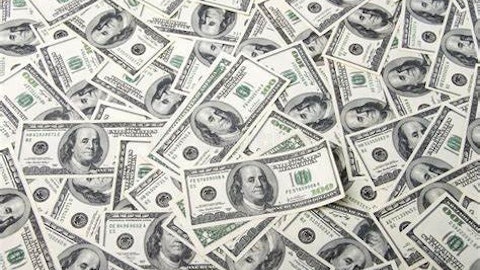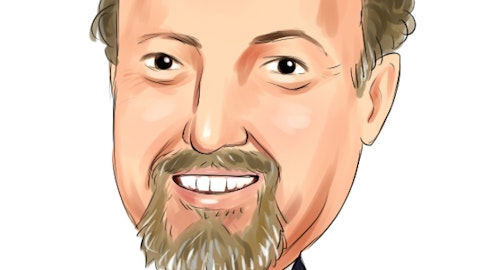Christopher Muse: Oh, just as you think about those billion dollars plus opportunities, particularly around advanced packaging, and I guess including HBM within that, and also gate-all-around, how you think you’ll fair relative to WFE in ‘24?
Timothy Archer: Yes, I think given the mix we see in some of these technology transitions, it should be incrementally better than it was last year for sure.
Christopher Muse: And then just as a quick second question, I guess third question, if I could sneak it in. You talked about normalization of China into the second half, and getting back to maybe a 46 percent-ish type of normalized gross margin. It sounds like China in your mind today is better, so I guess what would that number be if that continues to be strong for you guys? Thank you.
Timothy Archer: I guess, CJ, you’ve got to just kind of look at where we’ve been, right. You’re absolutely right, and thanks for mentioning the 46. That’s sort of where gross margin was after we had done some of the Malaysia stuff and before China popped up with those smaller customers. And so the fact that we’re above that level is largely customer mix. And so that’s how you should be thinking about it. And if we have that mix wrong, then margin kind of, you’ve got a couple of data points in the last couple of quarters that you can kind of solve for to understand what it might look like. It will be in that 46 to 48 -plus percent range depending on what the mix looks like.
Operator: Our next question comes from Atif Malik from Citi.
Atif Malik: Hi, thank you for taking my question. The first one for Tim. Tim, it’s good to see some green shoots in the NAND market. You talked about double-digit spare parts growth in the NAND. And you also talked about that the AI storage inflection for high density SSDs is in front of us. But we do not have the 3x wafer surface offset that you’re seeing on the DRAM site. So can you kind of paint for us the trajectory of the NAND improvement that you’re expecting into second half of your next year?
Timothy Archer: We’re not going to give you a ‘25 forecast quite yet. It’s way too early for that. It will be better though, right. I mean it’s improving in demo. Yes, well I guess without giving you exact numbers, I mean clearly, we all know that the NAND spending has been incredibly weak for the last 12-18 months. And so we’re in the very early stages of starting to see that recover. And I think if you look at what most of our — we rely on our customer commentary that they make publicly for a lot of this. But they talk about the fact that maybe 90% of the bits they’re shipping are at the leading etch. But when we look at the install base of our system, that was my comment. I believe that there’s still going to be a large portion of the install base that will move forward to the next technology nodes.
It’s the most efficient way for our customers to do that is to upgrade what they already have. And I think you’ll see that move forward. And therefore, NAND and WFE move up in ‘25. But because it comes to a large degree through upgrades, Lam’s capture rate of every dollar of WFE spent will be much higher than in a greenfield capacity added. So when I think about Lam’s opportunity to outperform in 2025, in NAND, I think it is obviously with high confidence because of the type of spending we would expect to be seen in 2025. And in the other market segments, it’s also pretty high because of the, as I mentioned, the technology inflections that are occurring. And it’s gate-all-around where we, this year we’ll actually have over a billion dollars of shipments into the gate-all-around technology nodes.
And obviously, as gate-all-around continues to proliferate, our tools like ALB and selective etch will do better in backside power delivery. We already talked about advanced packaging. And then, we obviously have out there in front of us also the work we’re doing for dry photoresist processes for EUV. And so I just feel like there are a number of growth drivers for the company besides the one that is the most obvious, which is a NAND recovery in 2025.
Atif Malik: Great, thank you. And then one for Doug. Doug, within your China, 42% of sales, you talked about multinationals picking up, which came as a positive surprise to me. Can you talk about what’s driving that? Are those customers not worried about incremental restrictions or are they just trying to upgrade some of the older technology?
Doug Bettinger : I think it’s just being responsive to the demand they see relative to the capacity that’s there. And yes, I said it’s the highest level since mid-last year. Although I do understand I don’t know over position that the vast majority of the spending in China continues to be the indigenous Chinese customer base. But I just observed it as I was going through the numbers and knowing everybody was going to be asking about China, that was something I thought I’d just mention.
Operator: Our next question comes from Toshiya Hari from Goldman Sachs.
Toshiya Hari: Hi, guys. Thank you so much for taking the question. I wanted to ask a question on NAND as well. Tim, in your prepared remarks, you talked about the transition from tungsten to molybdenum potentially happening in the market, I suppose, over the next couple of years. Can you speak to the significance of that in terms of depth, intensity, and how that could impact your business over the next couple of years? Thanks.
Timothy Archer: Sure. Well, obviously, any time there’s a material change requires a new system, it’s an opportunity for Lam to provide that technology into the market, and so it’s an important change. We would call it moly just because it’s so hard to say molybdenum, but the change to moly has some significant device benefits, and also, I mentioned that the important thing in NAND is, I mean, it’s important in every element of semiconductor devices, but it’s the cost and technology, and so one thing that’s sometimes lost is part of the transition to moly is also about enabling stack height reduction, so you can go to more layers and limit the stack height in a way that allows you to then have more productive and just more productive depth issue and other things. And so, I think it’s an important inflection for the industry and an opportunity for Lam, and we’re well positioned to win that inflection literally.
Toshiya Hari: Got it. Thank you. And then as my follow-up on HBM, you talked about your business growing more than 3X year-over-year, I think, and I think that comment was consistent with what you had communicated last quarter. Based on sort of the input you have, the market intel you have, what kind of growth or market growth in HBM, do you think that increase in your business supports in ‘24 and obviously demand is very strong, but how are you thinking about supply demand from your perspective exiting the year and into ‘25 in HBM? Thank you.
Doug Bettinger : Appreciate it. Maybe I’ll give it a try. I mean, when you look at overall good demand, HBM is probably a point or two of it, although it’s growing and adding to the broad market. But it’s clearly requiring incremental investment of our SABRE 3D tool, our deep silicon etch tool. And I think it’s something you’re going to hear us talking about for many years to come. This form factor is going to continue to be important relative to AI enablement, feeding the GPU the data that it needs. Small today, but growing quite rapidly.
Operator: Our next question comes from Joe Moore from Morgan Stanley.
Joseph Moore: Great, thank you. I wanted to follow up. You had mentioned that there was a customer that you’re classifying as NAND, that others might be classifying as DRAM. I just wanted to double click on that. If you could talk to what’s going on there, is that customer doing both and people just have different classifications? Should we be thinking that there’s more NAND capacity coming on in China than I had thought before? Can you just talk to that change?
Doug Bettinger : I guess all I’d say, Joe, is sometimes there could be a little bit of confusion. And I felt that as I was talking to people over the last quarter. So the reason I said it was, it’s actually a non-volatile device or it’s got non-volatile components. And early on, because of that, we put everything into non-volatile memory. So non-volatile memory is more than NAND. This isn’t an enormous number, but it’s big enough that I wanted people to hear us tell you where it is and you can go think about it. And you probably know who the customer is. I’m not going to disclose it here, but it is one customer in specialty DRAM.
Joseph Moore: Got it. Thank you for that. And then on the Reliant business, can you talk about changes in that business as we sort of move into a lower level of utilization in trailing etch nodes? Do you see that kind of returning to more of a refurbished tools business, where there’s stuff that you’re able to actually refurbish and any ramifications we should think about for profitability there?
Timothy Archer: Yes, I guess I’ll just come in and refer. I would be surprised if we moved back towards a customer’s investing of equipment from fabs and us being able to refurbish those tools. I think you could see obviously the ebbs and flows with demand of how many new tools we ship but I think it still remains mostly as a new tool trailing etch node business for us.
Operator: Our next question comes from Stacy Rasgon from Bernstein Research.
Stacy Rasgon: Hi, guys. Thanks for taking my questions. Doug, I wanted to go back to something you just mentioned here around the relative capital intensity of upgrades versus greenfield investments for NAND as we get into ‘25. And I get the idea that you should take a larger share of upgrades but am I thinking about this wrong? Wouldn’t the absolute amount of WFE in an upgrade -driven cycle be a lot lower than if it was in a greenfield cycle? Like how do I think about the puts and takes of those two variables in the context of NAND growth into 2025?
Timothy Archer: Sure, Stacey. I’ll take that. I was actually the one who said the comment. Yes, no problem. I just wanted to own it in case you disagree so. I think you’re thinking about it exactly right. The reason upgrades are so attractive for customers is the total WFE spend is lower. That’s why they upgrade the installed base. And so for my comment was specifically about Lam’s outperformance relative to whatever WFE is for the industry next year. In an upgrade heavy cycle, which obviously we haven’t had for the last two years in that next cycle of NAND upgrades, we’re saying we would capture a higher percentage of whatever that WFE is. Now, we’ve said in the past that Lam’s opportunity, actually, because of that much higher capture rate is not so different in terms of revenue for every bit added through an upgrade versus a greenfield.
So if WFE comes down, that’s why it’s attractive for customers. But for Lam, we capture almost the same amount of revenue because of the much higher capture rate, and so kind of both ways.
Stacy Rasgon: So you’re indifferent to like an upgrade cycle versus a greenfield cycle?





